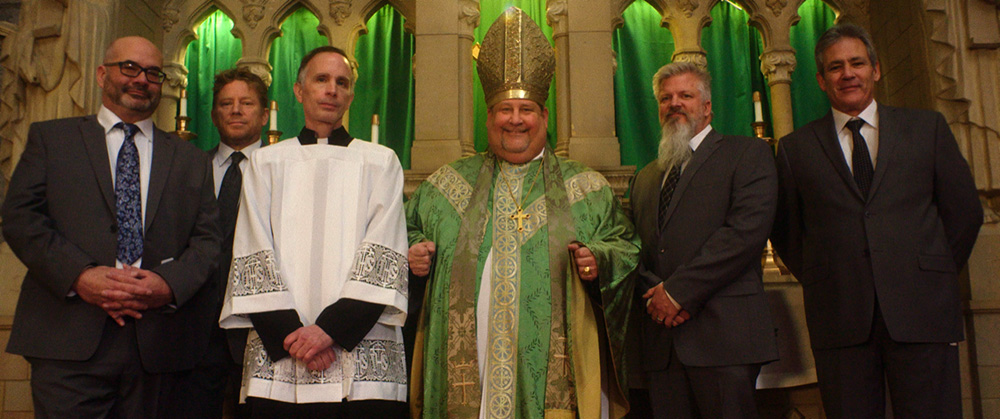We’re going to make our point.
The film begins with a press conference where Michael Sandridge, Tom Viviano, and Mike Foreman—all survivors of abuse—discuss how the Catholic Church in Kansas allowed their priests to groom and assault them. It’s an obviously tense scene in large part because of how the Church has engaged in a coordinated cover-up that has spanned decades, moving pedophiles around to deflect and confuse while simultaneously expanding the number of their victims. Foreman is justifiably enraged as he incredulously scoffs at the fact that the establishment has propped itself upon the salvation of statutes of limitations rather than the empathetic, Christian principles dictated via confession. Those in power would rather hide and lie than admit their complicity all while sanctimoniously asking us to believe they’re God’s chosen few.
It’s no surprise then to learn director Robert Greene approached the trio’s mutual lawyer Rebecca Randles about the potential of doing this movie, Procession, about them. He has made a name for himself in recent years with a unique sensibility of merging documentary and reenactment to get closer to truths that neither could reach by themselves. With the help of Monica Phinney, a professional drama therapist, Greene was able to talk Sandridge, Viviano, Foreman, Ed Gavagan, Dan Laurine, and Joe Eldred into allowing him to capture what would become a three-year process of confronting their respective nightmares via the catharsis afforded by transferring their pain into the art of writing short films depicting its source. Through each other’s support, these six men band together to search for healing.

And boy is it effective. I haven’t been so invested and in awe of a documentary since 2017’s The Work. Because this isn’t just about the writing and filming of vignettes meant to lift the heavy burdens that have been crushing them since adolescence. It’s about the camaraderie of being around people who not only believe them, but also know the effects of what happened first-hand. That level of kinship is crucial to their willingness to be completely vulnerable sans judgement and to push themselves to places they would never have felt comfortable enough going alone. Viviano, for example, is still awaiting his court date and thus is legally unable to tell his truth in public. Even so, he volunteered himself to his new “brothers” to facilitate theirs.
They all do. Laurine is a location scout who took point where finding suitable sites for reenactments was concerned. While he’s surely had to visit churches throughout his career, doing so for this purpose proves a lot more meaningful and emotional. And he takes things even further when asked to search for the actual settings of some of these men’s assaults. Laurine and Sandridge—who can no longer revisit his own horror due to the building being torn down—positioned themselves as leaders willing to advocate for the others who psychologically couldn’t do so themselves. Why? Because they know that fear. What they do for Eldred to find the lake house from his nightmares is something Laurine’s brain can’t quite do for himself (and we’ll watch him try).
The result sees a thoughtfully and impactfully cut work (Greene also serves as editor) moving between process and finished product in contextually relevant and heartfelt ways. The former sees the men during their day-to-day, hashing out material, and rehearsing, each struggling to decide what incidents will help soothe their present as well as what won’t since some must exorcise their demons as others merely seek to confront them. And the latter captures each in performance. Viviano becomes the de facto priest in most sequences with Sandridge donning clerical garb when needed too. They become the men that abused whoever’s turn it is to lay their soul bear as young Terrick Trobough performs their youthful selves as vessel, memory, and sounding board alike by bravely giving their pasts life.

Trobough’s part in this exercise cannot be discounted both because he’s willing to see the role as a job that allows him to deliver what’s needed without (hopefully) being affected by the weight of the subject matter and because he supplies them a physical representation of that which many have avoided. Eldred speaks often about his inability to “talk” to his former self through letter and no one can blame him for fearing what doing so might dredge up. Having Trobough there as a stand-in, however, lets him (and Foreman, Laurine, and the others) get out of their own heads to create a concrete division between orator and listener. They can finally see themselves outside of themselves and reconcile the duality of their fractured identities for necessary healing.
It’s a revelatory experience for the men involved and surely for anyone watching who has gone through similar tragedies. Just watching them meet for the first time and share their stories proves as much considering how strong a bond is formed. Whether Sandridge and Gavagan acting like they’ve known each other for years or Eldred and Laurine realizing their tales were almost identical despite taking place at two different churches/lakes creates a level of understanding that they may have never had before. Because while they dive into their own pasts to dredge up their nightmares, the other five are always by their side with active support. This is art therapy as well as group therapy. It’s trust, candor, and belief. They’re taking back control of their lives together.
photography:
[1] Procession. (L to R) Joe Eldred, Ed Gavagan, Michael Sandridge, Tom Viviano, Dan Laurine and Mike Foreman in Procession. Cr. Netflix
[2] Procession. (L to R) Terrick Trobough and Joe Eldred in Procession. Cr. Netflix © 2021
[3] Procession. Michael Sandridge in Procession. Cr. Netflix © 2021


